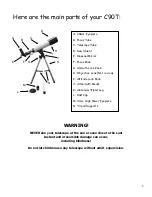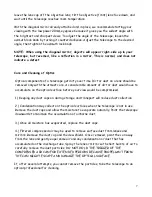
9
Jupiter is the largest planet in our solar system and the second brightest next to
Venus. Jupiter has many moons, four of which are often visible through your telescope,
when viewing conditions permit. As you watch them throughout the evening, you will see
that they change position relative to each other and to Jupiter. It is possible with
careful planning to actually see one of the moons disappear either in front of or behind
Jupiter as it orbits around the planet.
Saturn, the second largest planet, is not as bright as Jupiter and so its moons are not as
visible through small telescopes. The large rings that encircle Saturn are spectacular to
observe, however. The planet and its rings appear pale yellow.
Beyond our solar system, there are many more objects to be found. Galaxies, nebulae,
and star clusters abound!
FREQUENTLY ASKED QUESTIONS:
1) How far can I see?
If you stand outside and look up at the night sky on a clear evening, you can see
hundreds of stars with the unaided eye. The telescope is a light-gathering instrument
which magnifies the view—providing significantly more detail and unveiling more stars,
nebulae, and celestial objects. With the aid of a telescope, you will be able to enjoy
exciting views of Saturn’s rings, Jupiter’s major moons, the Orion Nebula, and much
more.
2) Why can’t I see anything?
If you see only gray or black when looking through your telescope, even after searching
for an object to view, it is very likely that you are using an eyepiece that is too
powerful. To solve this problem: Always start with the lowest power eyepiece first, and
only insert the higher power eyepiece after you have found an object.
3) When I use my high power eyepiece, everything looks much darker. Why?
As magnification in a telescope increases, brightness diminishes. Conversely, brightness
increases when magnification is reduced. If an image appears too dark or unclear, use a
lower-powered eyepiece. Views of small, bright objects are better than those of large,
dark or blurry ones! Atmospheric conditions, air currents, as well as light and air
pollution also affect viewing quality.















